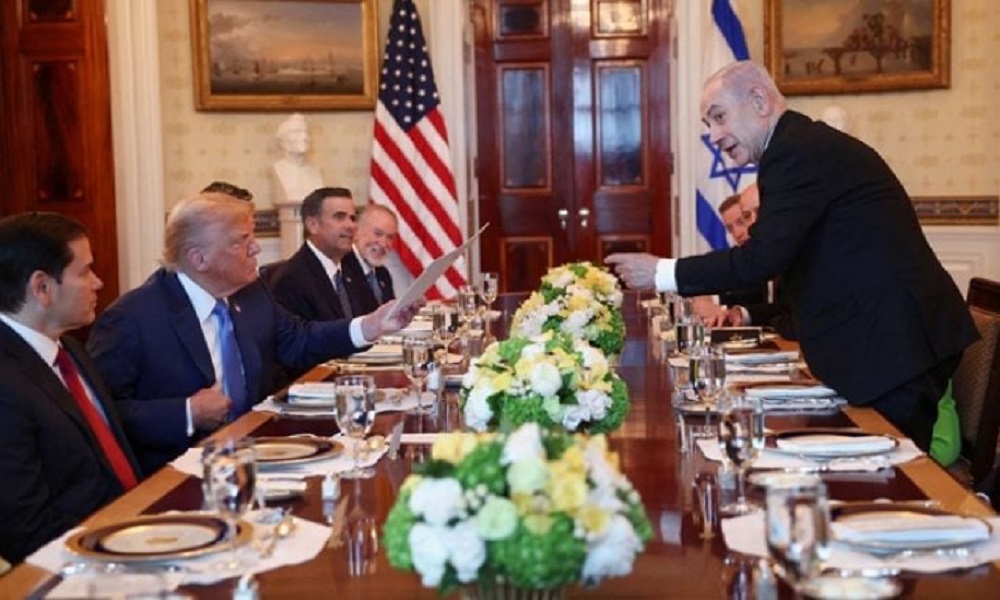Trump and Netanyahu’s Diverging Dreams: Redrawing the Middle East in Chaos
While Trump seeks a symbolic ceasefire in Gaza to seal his legacy, Netanyahu thrives on regional instability—fueling genocide and resisting post-war planning.

Watan-According to French outlet Mediapart, Donald Trump is pushing hard to impose a ceasefire in Gaza on Israeli Prime Minister Benjamin Netanyahu, who visited Washington on Monday. But Israel itself, a key architect of the current regional chaos, is obstructing the “American peace” vision Trump wants to promote.
Despite publicly dismissing Hamas’s conditions as “unacceptable,” Netanyahu sent a negotiating team to Qatar on Sunday. As with previous negotiation cycles, Israel ramped up its aerial assaults on Gaza in the days before. For Netanyahu, securing a ceasefire in Washington could be spun as a victory, especially given Israel’s lack of any serious post-war strategy for Gaza—apart from continuing its genocidal campaign to avoid addressing what comes next.
Trump’s “Next Deal”
The proposed agreement envisions a 60-day temporary ceasefire. During this period, negotiations for a permanent end to the war would resume. Israel would receive 10 hostages on Day 1 and another 10 on Day 50. The bodies of 18 other hostages would be returned gradually. Israel estimates that around 50 hostages remain in Gaza, half of whom are likely dead. Hamas would refrain from releasing footage of the hostages’ return, unlike in previous ceasefires. In exchange, Palestinian prisoners would be freed.
However, three main points are stalling progress:
-
Hamas demands stronger guarantees that a ceasefire will eventually lead to a full end to the war.
-
Disagreements over the Israeli army’s withdrawal roadmap from Gaza persist.
-
Hamas demands the closure of the “Gaza Humanitarian Foundation” (GHF), an Israeli-controlled mechanism for aid delivery. Since GHF’s establishment on May 27, over 600 Palestinians have died trying to obtain flour. Palestinians want aid oversight restored to the UN and international NGOs.
Upon returning to power in January, Trump moved swiftly to enforce a Gaza ceasefire, in stark contrast to his predecessor Joe Biden, whose red lines resulted in no real action—leaving Gaza devastated.
Mediapart argues that Trump isn’t driven by ethics. Rather, he wants to be “the dealmaker”. Netanyahu’s current U.S. visit—despite his ICC arrest warrant—aligns with Trump’s broader plans for reshaping the region.

Clashing Agendas
As international relations scholar Philippe Golub notes, there is an overlap in the two leaders’ goals, but their intentions differ:
-
Netanyahu wants maximum autonomy, even in Gaza.
-
Trump wants Netanyahu to fall in line with U.S. strategy—focused on creating a new Middle East axis around Saudi Arabia, the Gulf States, and Israel—geared toward economic prosperity, not political resolution.
This comes after Trump recently ended a 12-day war between Israel and Iran, eager to remain the region’s central power. But this ambition is built on ignoring political realities and marginalizing the Palestinian cause.
Israel’s Goal Is Domination, Not Stability
Having weakened Iran and its allies—Hezbollah, Hamas, Assad, and the Houthis—Israel has reasserted regional military dominance. But that dominance brings destabilization, through sovereign bombings, illegal annexations, and ongoing genocide in Gaza.
Mediapart quotes journalist Sylvain Cypel, author of Israel Against the Jews:“Netanyahu’s goal isn’t peace—it’s chaos. In chaos, only brute power remains. The supremacist and messianic factions in Israel’s government want endless war. This appeals to an Israeli society high on its sense of unchecked power—despite deep existential fears.”
Netanyahu arrives in Washington emboldened by Israel’s strikes on Iran. During Trump’s first term, his pro-Israel stance was evident: he moved the U.S. embassy to Jerusalem, legitimized settlements, normalized ties between Israel and Arab states (the Abraham Accords), and withdrew from the Iran nuclear deal.
But This Time Is Different
Although Trump still supports Israel publicly, Mediapart notes signs of growing tension with Netanyahu. His insistence on a Gaza ceasefire isn’t rooted in morality but in legacy-building—he wants to be remembered as the architect of a “Middle East peace” centered around Saudi Arabia.
Golub explains:“He doesn’t have much time. He wants a Saudi deal—either for a Nobel Peace Prize or for historical recognition. And this requires ending the Gaza war.”
However, the plan lacks any realistic post-war vision. Gaza lies in ruins. Over 57,000 Palestinians have been killed since October 7. Saudi Arabia still insists that recognizing a Palestinian state is a non-negotiable precondition for normalization.
Aside from minor tech deals, Arab countries gained little from Trump’s 2020 normalization push. No unifying regional vision has emerged since the failure of the Arab Spring in 2011. The existing power balance among Iran, Israel, Saudi Arabia, and Turkey blocked any democratic aspirations.
That balance collapsed on October 7, says Mediapart, even before Trump’s return to power. Now, U.S. and Israeli plans—driven by security and economic interests—have no political horizon, only deepening chaos.
Neither Trump nor Netanyahu has a vision for “the day after” in Gaza, Lebanon, Syria, or Iran—except what far-right Israeli nationalists fantasize about: a “Greater Israel” that swallows large parts of neighboring countries.

And Europe? Powerless
Once imagined as a guarantor of international law, Europe is now irrelevant. Most EU states unconditionally support Israel, ignoring mass Palestinian, Lebanese, and Iranian casualties. Mediapart concludes that this growing detachment cements Europe’s marginalization in the region.






